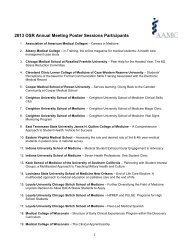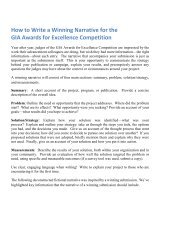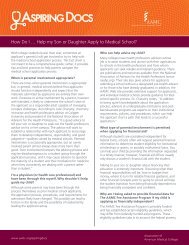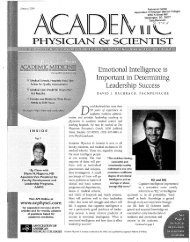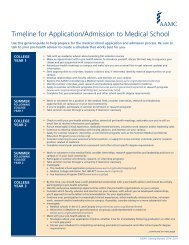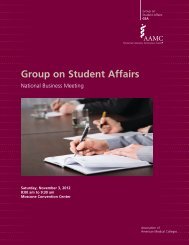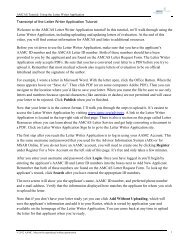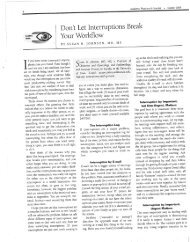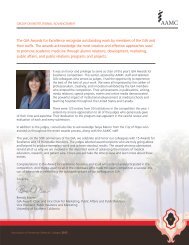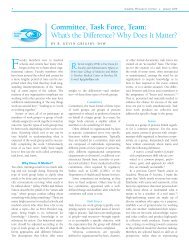Webinar Q&A summary - AAMC
Webinar Q&A summary - AAMC
Webinar Q&A summary - AAMC
You also want an ePaper? Increase the reach of your titles
YUMPU automatically turns print PDFs into web optimized ePapers that Google loves.
January 23, 2013, <strong>Webinar</strong><br />
Report from the NIH Diversity in the Biomedical Research Workforce Implementation Team<br />
Summary of Questions and Answers with Dr. Lawrence Tabak<br />
1. Q: When does the NIH anticipate the planning grants for the Building Infrastructure<br />
Leading to Diversity (BUILD) Program will be issued? When will the request for<br />
proposals (RFPs) for the full BUILD Program grants be announced?<br />
A: The NIH will issue funding opportunity announcements (FOA) for the planning<br />
grants in fiscal year (FY) 2013. The NIH envisions issuing the FOAs for the full<br />
program in late FY2013 or early FY2014 such that the grants will be funded in FY2014.<br />
2. Q: Did the committee look at any successful bottom-up approaches to recruit or retain<br />
African-American or other underrepresented minorities in biomedical disciplines?<br />
A: The NIH reviewed many examples of different efforts across the country for<br />
approaches to this, including a number of small grassroots activities where people selfassembled.<br />
Although the committee heard many positive anecdotes about these efforts, it<br />
was challenged by the lack of analyzable data related to these activities, thus making it<br />
difficult to predict the ability to scale up to what the NIH hopes will be a nationwide<br />
effort. Although the framework may be considered top-down, the BUILD Program is<br />
very much a bottom-up approach. BUILD institutions may partner with whomever they<br />
wish, provide a resource set that they can use for the students they select, provide<br />
infrastructure to whatever end the institutions feel they need it, and provide an innovation<br />
space where they can propose exactly the sort of thing that the questioner is speaking to.<br />
The NIH understands that the local solutions that work in one area may not necessarily<br />
work in another. The BUILD and National Research Mentoring Network (NRMN)<br />
Coordinating and Evaluation Center will collect and evaluate data in real time to have a<br />
good sense of the types of efforts that work.<br />
3. Q: It appears that the BUILD Program is focusing on institutions with low levels of<br />
funding. Is there a role for research-intensive institutions with high levels of NIH<br />
funding to participate in the BUILD Program?<br />
A: There is absolutely a role for research-intensive institutions. It is the NIH’s hope that<br />
the primary site institutions will reach out to research-intensive institutions and engage<br />
them in partnerships to be part of the BUILD consortium. Research-intensive institutions<br />
will be given the opportunity to be the training site for a uniquely diversified pool of<br />
highly talented and motivated young people either during the summers of their<br />
undergraduate years or post baccalaureate. The students will be supported by the BUILD<br />
program, and there will be modest research support provided.<br />
1
January 23, 2013, <strong>Webinar</strong><br />
Report from the NIH Diversity in the Biomedical Research Workforce Implementation Team<br />
Summary of Questions and Answers with Dr. Lawrence Tabak<br />
4. Q: Can BUILD primary institutions have multiple research-intensive university partners?<br />
A: Yes, the NIH hopes that the primary sites enter into a number of partnerships to<br />
complement the opportunities that they can provide to their students.<br />
5. Q: Will funding for programs such as Minority Access to Research Careers-<br />
Undergraduate Student Training for Academic Research (MARC U-STAR), Minority<br />
Biomedical Research Support -Research Initiative for Scientific Enhancement (MBRS-<br />
RISE), and MBRS -Initiative for Maximizing Student Development (IMSD) be<br />
maintained at current levels with this new initiative?<br />
A: There is no intention to reduce resources for these existing NIH programs. The NIH<br />
views the BUILD Program as being complementary to these other programs.<br />
6. Q: What is the role of historically black colleges and universities (HBCUs) in the<br />
BUILD and NRMN Programs?<br />
A: The NIH envisions HBCUs playing a major role in these initiatives. Depending upon<br />
the strengths of the particular HBCU, they could either serve as a primary site or they<br />
may serve as a research-intensive site. As more young people matriculate into PhD<br />
programs relevant to biomedical research, the NIH hopes that all PhD programs,<br />
including those at HBCUs, will benefit from a much more diversified applicant pool.<br />
7. Q: For pipeline programs like BUILD, what are some examples of metrics for success?<br />
A: The overall goal of the program is to increase the diversity of the biomedical research<br />
workforce. The primary site institutions will each articulate their own success metrics.<br />
8. Q: Will the Coordinating and Evaluation Center award be contemporaneous with the<br />
BUILD and NRMN awards or will there be some delay?<br />
A: The NIH is still working out the timing, but the awards would certainly be very close<br />
to one another.<br />
9. Q: How will the evaluation function of the Coordinating and Evaluation Center be<br />
sustained beyond the initial support from NIH? Would the expectation be that the Center<br />
being self-sustaining beyond that period of time?<br />
A: Common Fund programs typically have a lifespan of between seven and ten years.<br />
The expectation is that if the program is successful, the NIH would consider alternate<br />
ways of supporting the program after the initial support period.<br />
10. Q: Will those schools with existing programs (i.e., MARC or NBRS) be eligible to apply<br />
as a BUILD primary institution?<br />
2
January 23, 2013, <strong>Webinar</strong><br />
Report from the NIH Diversity in the Biomedical Research Workforce Implementation Team<br />
Summary of Questions and Answers with Dr. Lawrence Tabak<br />
A: The NIH will not exclude organizations that already have NBRS and/or MARC<br />
funding. The institutions must meet the general criteria articulated for the BUILD<br />
Program and will need to articulate how their existing programs, MARC or NBRS, will<br />
synergize with the BUILD Program.<br />
11. Q: Is the initiative directed at PhD scientists, or does it also include MD scientists?<br />
A: This program is devoted to increasing the numbers of diverse students entering a PhD<br />
program relevant to biomedical research.<br />
12. Q: If there is an MD who is doing basic research, would that physician scientist be<br />
eligible to be part of this?<br />
A: All individuals regardless of their educational pathway could serve mentorship roles<br />
either by supervising research experiences or by serving as a mentor in the NRMN.<br />
13. Q: Is there an effort on the part of NIH to consider geographical diversity in funding the<br />
planning grants?<br />
A: Yes, geographical diversity will be considered.<br />
14. Q: Will the BUILD initiative include a focus on training of postdoctoral researchers?<br />
A: BUILD is focused on undergraduate trainees and their transition to graduate level<br />
programs. However, the NIH envisions postdoctoral researchers as being engaged in the<br />
NRMN.<br />
15. Q: Does the NIH envision involving liberal arts colleges as part of the BUILD Program?<br />
A: Those liberal arts colleges that meet the BUILD Program general criteria are welcome<br />
to participate either as a primary site or may participate as a pipeline partner. The NIH<br />
would like to make the network as diverse as possible so that it provides the maximum<br />
number and flexibility of opportunities for the undergraduates that participate in the<br />
program.<br />
16. Q: Is the NIH considering a potential role for professional discipline-specific societies in<br />
these new initiatives?<br />
A: Professional societies may participate in several ways. First, they could participate in<br />
the NRMN. Many professional organizations have mentoring programs and one could be<br />
informed by those experiences and build upon those. Second, professional organizations<br />
may agree to partner with the primary site organizations to offer some unique<br />
programming opportunity or some unique mentoring opportunity. However, professional<br />
organizations can not directly apply for the BUILD Program.<br />
17. Q: To whom will the new NIH Chief Officer for Scientific Workforce Diversity report?<br />
3
January 23, 2013, <strong>Webinar</strong><br />
Report from the NIH Diversity in the Biomedical Research Workforce Implementation Team<br />
Summary of Questions and Answers with Dr. Lawrence Tabak<br />
A: This individual will report directly to Dr. Collins.<br />
18. Q: Will institutions also track the research record of those disabled researchers?<br />
A: The NIH has little information about individuals with various disabilities who<br />
participate in the workforce. The NIH would like to track individuals within the BUILD<br />
Program and beyond to do a much better job of enumerating and tracking the NIH<br />
trainees and workforce.<br />
19. Q: The NIH has been encouraging institutions to do tracking and evaluation. Does the<br />
NIH see in the future that this would be mandatory for future training grants?<br />
A: The NIH, as a result of recommendations from the Advisory Committee to the<br />
Director Biomedical Research Workforce Working Group, led by Drs. Shirley Tilghman<br />
and Sally Rockey, will be announcing initiatives related to better tracking of all of our<br />
trainees and investigators. It has not yet been determined if tracking will be mandatory.<br />
20. Q: Could the BUILD primary site institution also partner with high schools to develop<br />
research and mentoring programs for high school students entering the field of<br />
biomedical research?<br />
A: This has not been explicitly discussed by the NIH. If an institution wants to make a<br />
compelling case for using some of the innovation funds to partner with local high<br />
schools, that could be considered. However, the main focus of the BUILD initiative<br />
begins at the undergraduate level.<br />
4



